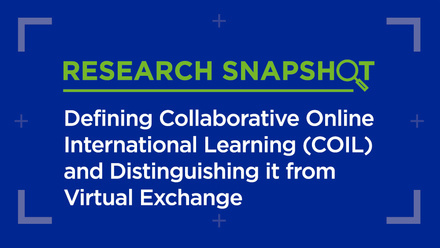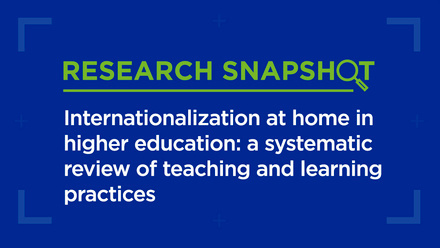Virtual exchange and Internationalisation at Home: navigating the terminology

When the COVID-19 pandemic suddenly closed borders and shuttered classrooms, many educators worldwide responded by embracing digital forms of teaching and learning nearly overnight. In the year and a half since, virtual exchange (VE) has become one of the hottest topics in international higher education – but how do we define it and what is it actually? What is it not, and how does it figure into broader institutional approaches to internationalisation?
‘Virtual exchange’ is an umbrella term used to refer to the many different ways in which students are engaged in online collaborative learning with partners from other cultures as part of their educational programmes. Over the past three decades, approaches to VE have evolved in different contexts and different areas of university education, and these approaches have also differed in terms of educational objectives, pedagogical design and forms of online interaction. As a result, the activity has assumed different names and terminology depending on the educational context and the pedagogical focus of its practitioners.
What’s in a name?
In the field of foreign language education, for example, VE has been referred to as ‘telecollaboration’, or ‘online intercultural exchange’. One particularly popular model of virtual exchange designed for foreign language learning is also called e-tandem or tele-tandem. In the field of business studies, on the other hand, practitioners often talk about ‘Bringing global perspectives to leadership in business’. In the USA, many institutions use the term ‘COIL’ – COIL: what’s in an acronym?, coined by Jon Rubin based on his work at the State University of New York COIL Center in the early 2000s – to refer to the different ways in which classes are connected in online collaborative projects with partner classes in other countries. To support Virtual Exchange, there is also now an annual conference on International Virtual Exchange (IVEC).
In VE, students engage in structured online intercultural dialogue with other learners as part of regular courses in their home institutions
The term VE itself seems to have emerged from the work of the Virtual Exchange Coalition comprising the organisations Soliya, iEARN and Global Nomads Group in 2011. The group defined VE as ‘technology-enabled, sustained, people-to-people education programs’. Since then, the term has been taken up by numerous other initiatives and networks working in the area, as well as by funders of research and practice in the area including the European Commission (who launched the Erasmus+ Virtual Exchange initiative) and in the USA by the Stevens Initiative.
‘Virtual exchange’, however, is not to be confused with ‘virtual mobility’. Virtual mobility involves students using online tools and platforms to follow courses at other institutions without physically leaving their homes. VE, on the other hand, is based on students engaging in structured online intercultural dialogue with other learners as part of their regular courses in their home institutions.
Key characteristics of virtual exchange
Despite the many different models and approaches to VE, there is a combination of common characteristics which enable us to differentiate VE from other online educational approaches and initiatives such as virtual mobility, MOOCs and online education courses in general.
Erasmus+ Virtual Exchange proposed the following key features for VE:
1. The focus is primarily on people-to-people interaction and dialogue;
2. The learning goals include soft skills such as the development of intercultural awareness, digital literacies, group work, etc.
3. It is primarily learner-led: following the philosophy of dialogue where participants are the main recipients and the main drivers of knowledge;
4. Intercultural understanding and awareness are not automatic outcomes of contact between different groups/cultures, and virtual exchange programmes explicitly address intercultural understanding and engaging with difference.
In order to differentiate VE from other, more social online activity such as participation in social networks, it is also helpful to add an additional criterion to those outlined by Erasmus+:
5. VE initiatives are generally integrated in some way into students’ formal learning; or, at least, students’ participation in the activity is provided with some form of academic recognition, whether it be in the form of grades, credit or badges.
Whereas delivery methods such as MOOCs clearly fail to meet the criteria of people-to-people interaction and being learner-led, proper virtual exchange always includes this holistic attention to the relationships between learners, cultural contexts and curriculum.
It is this emphasis on formal learning that makes VE particularly well-suited to being implemented under the umbrella of Internationalisation at Home (IaH) initiatives; while VE in itself is not synonymous with IaH, it can be a powerful instrument and catalyst in advancing efforts to internationalise home curricula.
Virtual exchange and Internationalisation at Home
The confusion about terminology and concepts is not limited to different approaches to VE: its rapid increase in popularity has in many institutions outpaced understanding of how it relates to Internationalisation at Home. In order to explore this relationship, we return to the definition of the latter: "…the purposeful integration of international and intercultural dimensions into the formal and informal curriculum for all students within domestic learning environments".
This requires thinking about the "purposeful" aspect of VE, which implies that teaching and learning should be outcomes-oriented and not just activity-based. This means that there are learning outcomes, assessment and reflection of the learning process by students and that there is alignment across a programme of studies. Interdisciplinary work, for example, can be done both ‘at home’ and online, and it is good to determine how each of these activities contribute to an internationalised curriculum.
While VE is not synonymous with IaH, it can be a powerful instrument and catalyst in advancing efforts to internationalise home curricula
The stipulation that these activities should be purposeful also relates to the skills of academics to design VE together with a partner abroad. In the scramble to switch to online learning, many VE practices remain activity- or experience-oriented with academics indicating that they need support in the design and delivery of VE.
In order to be purposeful, VE should be in alignment with other instruments that contribute to an internationalised home curriculum, such as comparison of cases and literature, comparative research and engagement with local international and cultural groups and organisations. For example, in diverse cities, intercultural competence can be learned in the local environment, but VE can enhance this through engagement with students and staff living abroad.
VE and IaH: complementary approaches to inclusion
Internationalisation at Home puts a strong focus on reaching all students. However, many VE practices still tend to be electives available to a limited group of students. Indeed, ‘upscaling’ such practices to include all students requires considerable effort. Therefore, we need to be careful not to assume that Internationalisation at Home and VE are inherently inclusive. For example, not all students have equal access to connectivity and devices, and there are various other exclusion mechanisms that can play a role in online collaboration, such as pedagogies and forms of assessment that favour some students over others. Proficiency in foreign language is also an aspect that can generate inequalities. Many of these aspects we know from physical international classrooms, but we need yet to find out more about how processes of inclusion and exclusion play out in virtual settings.
In the current situation, VE acts as a catalyst for internationalisation of teaching and learning in home curricula. But we should not forget the many other opportunities that the local environment provides for engagement with international and intercultural actors, and should be careful not to assume that a single VE activity can internationalise an entire curriculum.






